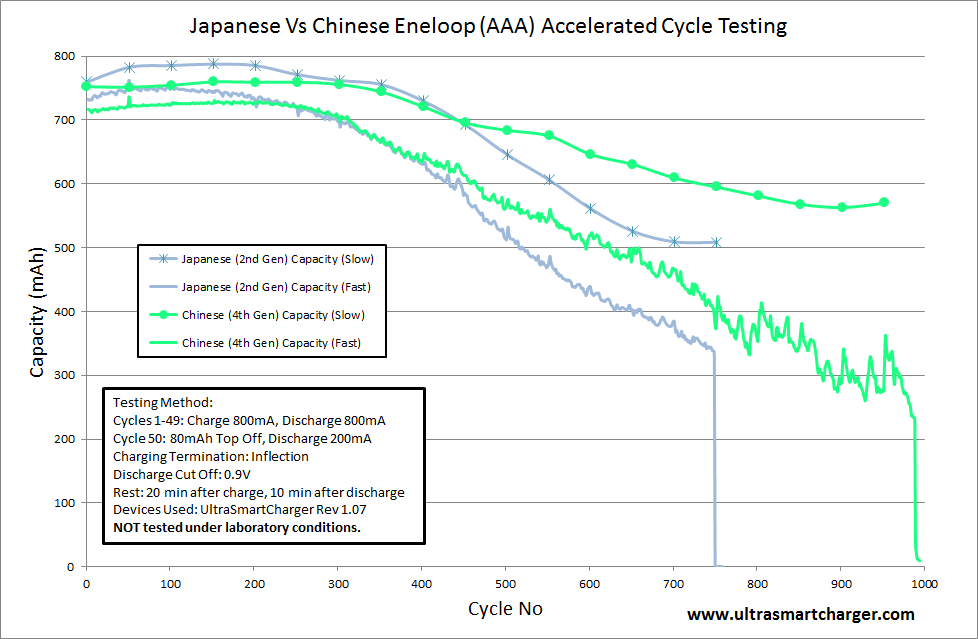Power Me Up
Enlightened
Following on from my previous test comparing Japanese Vs Chinese made AA Eneloops, I've run a similar test to compare the different versions in AAA size:

When looking at these results, it should be kept in mind that this test was only performed on 2 cells - one Chinese and one Japanese - it's possible that further testing may give different results due to individual cell variations.
Compared to the AA test, the Chinese made AAA has done exceedingly well - it actually lasted for more cycles than the Japanese made AA!
Considering the results from the previous testing that I've done, I was expecting the Chinese AAA to perform at a similar level to the 2nd gen Japanese AAA cell, but it actually outperformed it by a reasonable margin. At this stage, it's not possible to say why the Chinese made AA's performed so poorly when this AAA cell did so well. I can only speculate that the Japanese 4th gen cells will perform even better again and that the AAA cells are able to last longer than the AA cells under similar testing conditions - I suspect that even though the AAA cells are being charged at a 1C rate (the same as the AA cells) the fact that they have a larger surface area to volume ratio and that the charger will also be producing less waste heat at the lower charging rate, the AAA cells are staying cooler throughout the test which is then allowing them to last longer.
Unfortunately, at the time that I started this test, the newest Japanese made AAA Eneloops that I had were a few packs of 2nd generation cells, so the results can't be used to directly compare Japanese and Chinese manufacturing capabilities with the AAA cells. ChibiM has donated a pack of 8 4th Generation AAA Eneloops for testing purposes - I've already started a new test with one of those Eneloops and another Chinese cell.
For anyone wanting to purchase genuine Japanese Eneloops, you can obtain them from ChibiM here:
http://www.cpfmarketplace.com/mp/sh...ipping-directly-from-Japan-(newest-available)

When looking at these results, it should be kept in mind that this test was only performed on 2 cells - one Chinese and one Japanese - it's possible that further testing may give different results due to individual cell variations.
Compared to the AA test, the Chinese made AAA has done exceedingly well - it actually lasted for more cycles than the Japanese made AA!
Considering the results from the previous testing that I've done, I was expecting the Chinese AAA to perform at a similar level to the 2nd gen Japanese AAA cell, but it actually outperformed it by a reasonable margin. At this stage, it's not possible to say why the Chinese made AA's performed so poorly when this AAA cell did so well. I can only speculate that the Japanese 4th gen cells will perform even better again and that the AAA cells are able to last longer than the AA cells under similar testing conditions - I suspect that even though the AAA cells are being charged at a 1C rate (the same as the AA cells) the fact that they have a larger surface area to volume ratio and that the charger will also be producing less waste heat at the lower charging rate, the AAA cells are staying cooler throughout the test which is then allowing them to last longer.
Unfortunately, at the time that I started this test, the newest Japanese made AAA Eneloops that I had were a few packs of 2nd generation cells, so the results can't be used to directly compare Japanese and Chinese manufacturing capabilities with the AAA cells. ChibiM has donated a pack of 8 4th Generation AAA Eneloops for testing purposes - I've already started a new test with one of those Eneloops and another Chinese cell.
For anyone wanting to purchase genuine Japanese Eneloops, you can obtain them from ChibiM here:
http://www.cpfmarketplace.com/mp/sh...ipping-directly-from-Japan-(newest-available)

